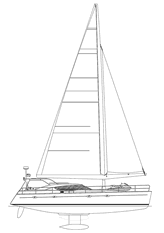Jutson 56
Cruiserr
While the Turner 56 is definitely a light boat this Jutson 56, at 48,730 pounds, is a heavy one, although it still manages to keep its D/L at 157. The hull is very deep and the lifting keel is quite far aft. In fact, from the viewpoint of the longitudinal center of gravity, I don't know how they got it that far aft. The distribution of beam shows a boat that could easily be stern heavy, and this should push the ballast forward. It must be the weight of the Carbospar and the jet ski combined with lots of heavy ground tackle. Still, to my eye it doesn't look quite right. Don't forget the weights associated with the large dinghy stowed in the lazarette. There are two stubby little rudders that will work with the keel-up draft of 5 feet, 6 inches. Keel-down draft is 9 feet, 2 inches. Beam is 16 feet, 5 inches for an L/B of 3.42.
The layout features a pilothouse with inside steering and dinette. The dinette is not raised, but the deep windows of the Jutson should allow for visibility while seated. Engine space and the keel trunk are below the pilothouse.
There is another large dinette on the lower level forward adjacent to the galley. The galley is big. Forward of the galley are upper and lower berths for four guests, who will share a forward head. The owner's stateroom aft has a head to starboard and a large shower stall to port. The fo'c'sle area is taken up by ground tackle stowage and a bow thruster. There is no general stowage forward that I can see. With the dinghy in the laz I don't see any general stowage aft either. I'd like to see far more deck access to large multipurpose stowage areas.
The deck plan shows minimal side decks and a large cockpit. I'm from the old school I guess, and I like broad side decks. This boat has a very wide stern and the cockpit takes advantage of that with two wheels and two wraparound seating areas forward with tables.
The driver will sit on an elevated powerboat-style helm chair so he can see over the pilothouse. The dinghy will launch with an extendable crane/davit from the large garage in the stern. There is a nest on the foredeck for a jet ski. I tried this a couple of times with my dog sitting between my arms. She liked it better than I did, and after 15 minutes I got bored and quit. I hate the noise and would just as soon see them all end up rusting in carports. The last thing I want in a secluded anchorage is a fool on a jet ski.
Oops, got off the track there. The cockpit uses a tubular wrapover arch structure to form a Bimini. Pulpits and lifelines are integrated into a stout pipe rail system.
The Aerorig by Carbospars is interesting. I am currently using one on an 85-footer. I dug as hard as I could for dirt on the rig, but I couldn't find any. I contacted Bill Dixon in the UK. He's used them several times and the best I could determine was that the darn things work very well. They seem to lack some power for light-air sailing, but I don't think light-air speed is part of the target with this type of boat. Some owners of early Aerorigs are coming back for a second Aerorig. It turns sailhandling into virtually a one-sheet exercise. There are no shrouds or sheet tracks, and the rig is very effective off the wind. The main can furl Leisure Furl style in the boom. It's odd looking, but that can change with time as you gain appreciation for its virtues.
An innovative yacht for the cruising public.

Comments